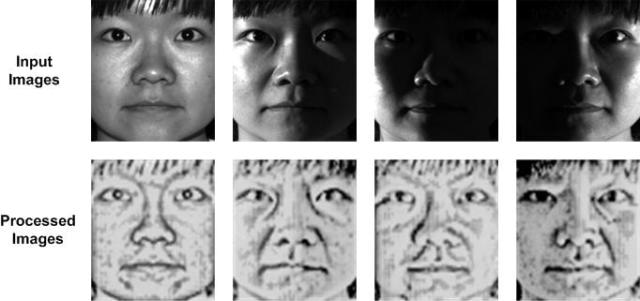Jul 20 2016
Vision-based face detection and recognition is one of the most rapidly growing research areas in computer vision and robotics and is widely used in several human related applications. However, vision-based face detection and recognition has been shown to be effective only under normal illumination conditions. In developing an algorithm for face detection and recognition, it is crucial to consider both normal and severe illumination conditions. One approach is to convert face images under various illumination conditions into ones with invariant face appearance while preserving the face-specific characteristics such as texture and facial features.
 Result of the illumination invariant face processing using Yale B Extended database: input images (top) and processed images (bottom).(Credit: COPYRIGHT (C) TOYOHASHI UNIVERSITY OF TECHNOLOGY. ALL RIGHTS RESERVED.)
Result of the illumination invariant face processing using Yale B Extended database: input images (top) and processed images (bottom).(Credit: COPYRIGHT (C) TOYOHASHI UNIVERSITY OF TECHNOLOGY. ALL RIGHTS RESERVED.)
Now, researchers at the Department of Computer Science and Engineering at Toyohashi University of Technology have developed a novel technique to adaptively adjust the effect of lighting on human faces by employing an extended reflectance model. The model has one variable (illumination ratio), which is controlled by Fuzzy Inference System (FIS). To cope with a vast variety of illumination conditions, the FIS rule was optimized using Genetic Algorithm (GA).
The first author PhD candidate, Bima Sena Bayu Dewantara, explained, "To eliminate the effects of light, image contrast should be adjusted adaptively. To produce an invariant face appearance under backlighting, for example, cheeks need to be brightened, while the eyeballs must be kept dark. Such an adaptive contrast adjustment can be performed using the developed reflectance model, and we show that a combination of Fuzzy Inference System (FIS) and Genetic Algorithm (GA) is very effective for implementing the model."
Professor Jun Miura said, "By just adding this contrast adjustment to present face recognition systems, we can largely improve the accuracy and performance of face detection and recognition. Moreover, this adjustment runs in real-time, and therefore, it is appropriate for real-time applications such as robot and human-interaction systems."
A face not only provides a person's identity but also provides other information such as a person's focus of attention and the degree of tiredness. Obtaining such information is useful for a comfortable human-machine interaction, and researchers expect that the proposed contrast adjustment method will also be useful in various situations, especially under severe illumination conditions.
The above research results were reported in the Machine Vision and Applications on July 15, 2016.